In this notebook I used transfer learning to build a neural network model based on a well known CNN architecture, VGG16, that classifies with high accuracy any image of 3 popular landmarks on Columbia University in the city of New York:


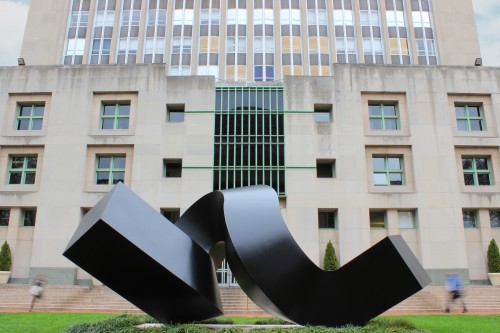
To see and test the model working, please visit: https://jacquelinearaya.github.io/portfolio/modelindex.
Import Tensorflow 2.0 and other libraries
try:
%tensorflow_version 2.x # enable TF 2.x in Colab
except Exception:
pass
`%tensorflow_version` only switches the major version: 1.x or 2.x.
You set: `2.x # enable TF 2.x in Colab`. This will be interpreted as: `2.x`.
TensorFlow 2.x selected.
import tensorflow as tf
print(tf.__version__)
2.4.1
import IPython.display as display
import matplotlib.pyplot as plt
import numpy as np
import random
import time
import pathlib
import glob
import os, shutil
from PIL import Image, ExifTags
from keras.preprocessing.image import ImageDataGenerator
from tensorflow.keras import datasets, layers, models
Some model specifications
AUTOTUNE = tf.data.experimental.AUTOTUNE
BATCH_SIZE = 32
IMG_SIZE = 256
SHUFFLE_SIZE = 1000
Connect to Google Drive to download dataset of images and unzip to local folder
# Connect to Google Drive (to load raw data)
!pip install -U -q PyDrive
from pydrive.auth import GoogleAuth
from pydrive.drive import GoogleDrive
from google.colab import auth
from oauth2client.client import GoogleCredentials
# Authenticate and create the PyDrive client.
auth.authenticate_user()
gauth = GoogleAuth()
gauth.credentials = GoogleCredentials.get_application_default()
drive = GoogleDrive(gauth)
files_name = {'dataset_columbia.tar.gz': '1NAQ7MSbyAcMidMwLQfJ0pIYmhu161awF'}
for key, value in files_name.items():
downloaded = drive.CreateFile({'id': value,
'title': key})
print("Downloading {} file ...".format(key))
downloaded.GetContentFile(key)
Downloading dataset_columbia.tar.gz file ...
#Untar locally Columbia Dataset
!pwd
!tar -zxf "dataset_columbia.tar.gz"
/content
!rm -rf "dataset_columbia.tar.gz"
base_dir = "dataset_columbia/"
base_dir_path = pathlib.Path(base_dir)
photo_paths = list(base_dir_path.glob('*/*'))
photo_paths = [str(path) for path in photo_paths]
random.shuffle(photo_paths)
labels = list(base_dir_path.glob('*/'))
labels = [str(path).replace(base_dir,'') for path in labels]
Check the paths to images and the labels
photo_paths[:5]
['dataset_columbia/uris/20191004_183131_013.jpg',
'dataset_columbia/uris/20191006_124543.jpg',
'dataset_columbia/uris/20191004_170254.jpg',
'dataset_columbia/uris/20191004_183103_003.jpg',
'dataset_columbia/alma_matter/20191004_183459_031.jpg']
labels
['uris', 'alma_matter', 'lion']
How many images are there to train the model?
n_photos = len(photo_paths)
n_photos
600
Let’s display some images from the loaded files:
for n in range(3):
image_path = random.choice(photo_paths)
display.display(display.Image(image_path, width = 285, height = 275)) #resize images to display
print()

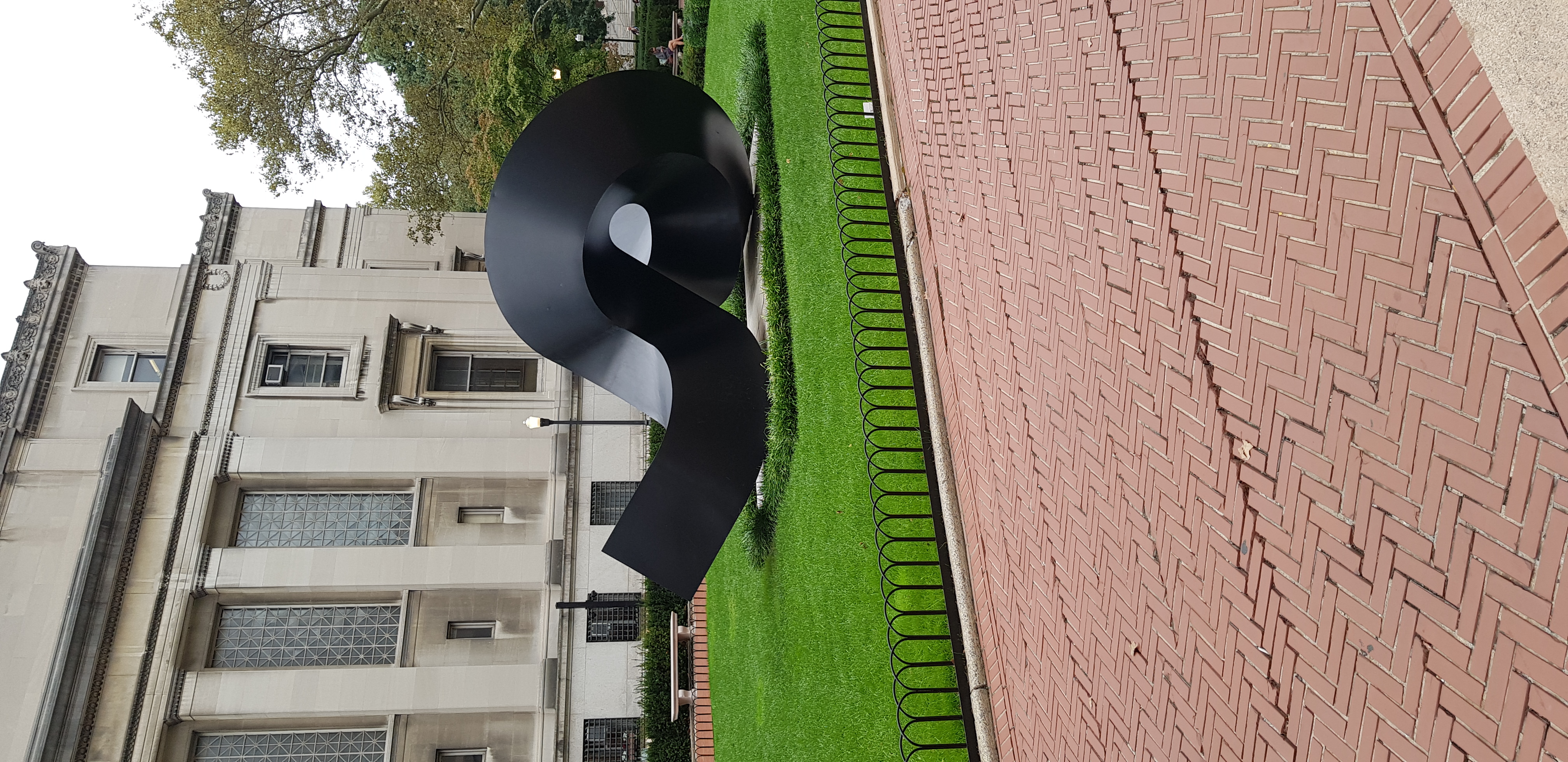
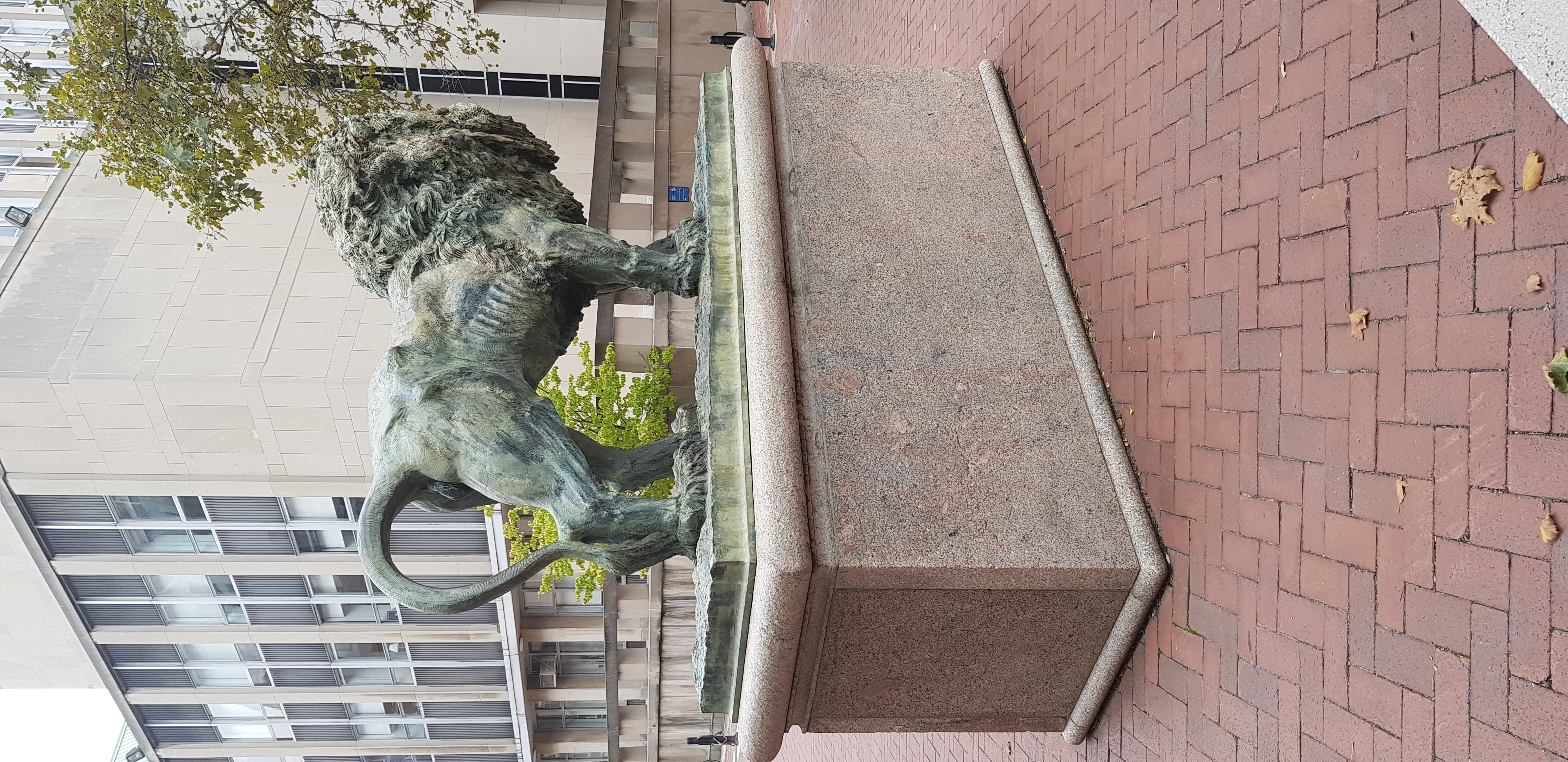
Preprocessing raw images
The original photos (taken by me) are rotated internally because they were taken with a smartphone in a vertical way, therefore I’ll use a function to change the original rotation of an image
def load_and_preprocess_image(path):
'''
Input: path of location of image
Output: image modified and saved on same path, no return
'''
try:
image=Image.open(path)
for orientation in ExifTags.TAGS.keys():
if ExifTags.TAGS[orientation]=='Orientation':
break
exif=dict(image._getexif().items())
if exif[orientation] == 3:
image=image.rotate(180, expand=True)
elif exif[orientation] == 6:
image=image.rotate(270, expand=True)
elif exif[orientation] == 8:
image=image.rotate(90, expand=True)
image.save(path)
image.close()
except (AttributeError, KeyError, IndexError):
# cases: image don't have getexif
pass
Once the function is applied the jpg files are modified locally
result = load_and_preprocess_image(photo_paths[2])
display.display(display.Image(photo_paths[2], width = 385, height = 375))
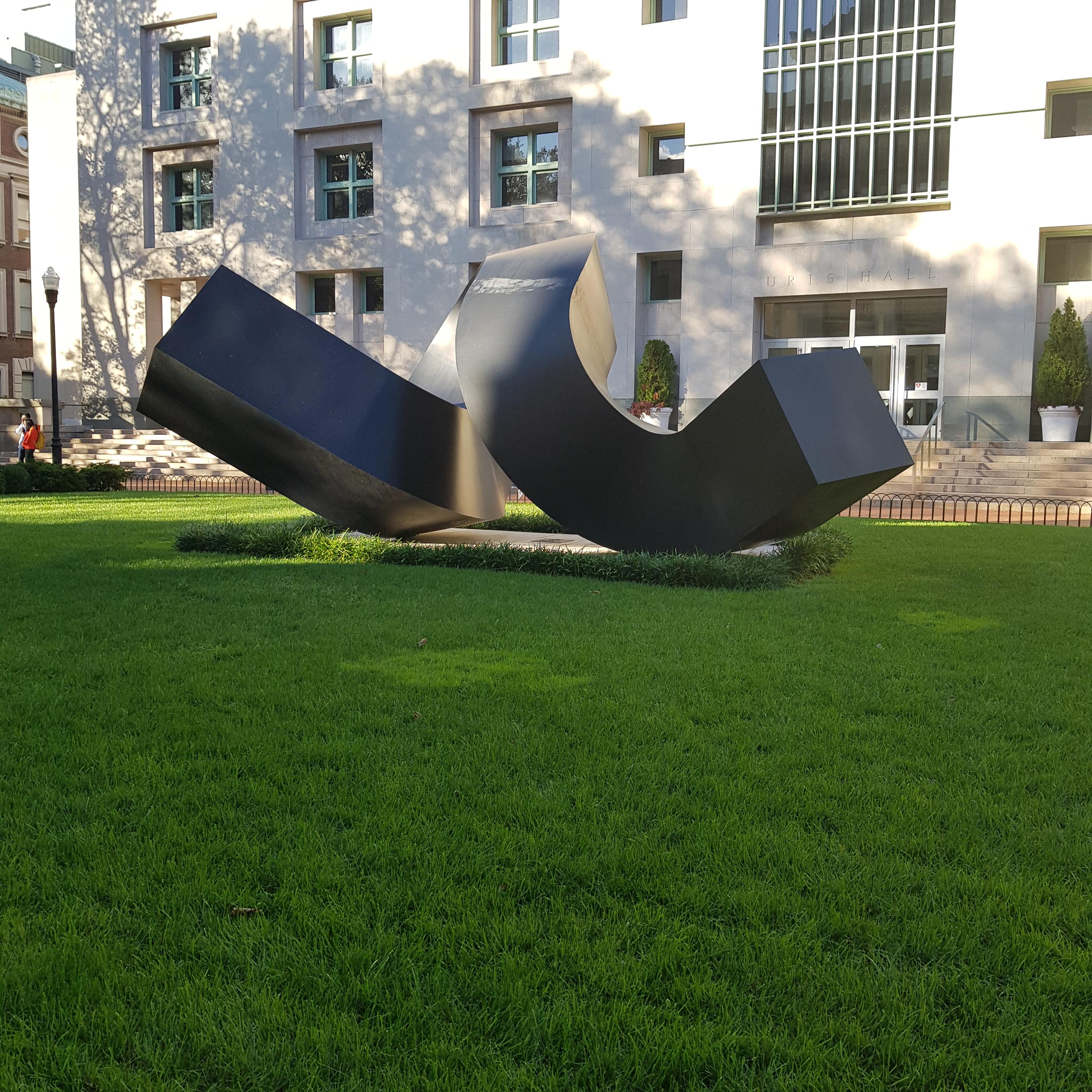
Create a Train/Test split of the images paths
Create train and test splits using Sklearn library
#split train/test for processed images
from sklearn.model_selection import train_test_split
train_paths, test_paths = train_test_split(photo_paths)
len(train_paths), len(test_paths)
(450, 150)
- Train images: 450
- Test images: 150
Preprocess images and copy them to the Train or Test folder according to the Train/Test separation
#Create separate directories to get a train and a test dataset
#Split base_dir_path (images pahts) into train and test folders
train_dir = 'train'
if not os.path.exists(train_dir):
os.mkdir(train_dir)
test_dir = 'test'
if not os.path.exists(test_dir):
os.mkdir(test_dir)
for l in labels:
train_label_dir = os.path.join(train_dir, l)
if not os.path.exists(train_label_dir):
os.mkdir(train_label_dir)
test_label_dir = os.path.join(test_dir, l)
if not os.path.exists(test_label_dir):
os.mkdir(test_label_dir)
#Copy images to each corresponding folder while processing them
for p in train_paths:
aux = os.path.basename(p)
photo_label = p[len(base_dir):-(len(aux)+1)]
dest = 'train/%s/%s'%(photo_label,aux)
load_and_preprocess_image(p)
shutil.copyfile(p, dest)
for p in test_paths:
aux = os.path.basename(p)
photo_label = p[len(base_dir):-(len(aux)+1)]
dest = 'test/%s/%s'%(photo_label,aux)
load_and_preprocess_image(p)
shutil.copyfile(p, dest)
train_dir_path = pathlib.Path(train_dir)
test_dir_path = pathlib.Path(test_dir)
Image generators
Use ImageDataGenerator from TF to create a generator that rescale images and create batches of images to feed to the model when training
train_datagen = ImageDataGenerator(rescale=1./255)
test_datagen = ImageDataGenerator(rescale=1./255)
train_generator = train_datagen.flow_from_directory(
train_dir_path,
target_size=(IMG_SIZE, IMG_SIZE),
batch_size=32,
shuffle=True,
class_mode = "sparse")
test_generator = test_datagen.flow_from_directory(
test_dir_path,
target_size=(IMG_SIZE, IMG_SIZE),
batch_size=32,
class_mode = "sparse")
for data_batch, labels_batch in train_generator:
print('data batch shape:', data_batch.shape)
print('labels batch shape:', labels_batch.shape)
break
for data_batch, labels_batch in test_generator:
print('data batch shape:', data_batch.shape)
print('labels batch shape:', labels_batch.shape)
break
Found 450 images belonging to 3 classes.
Found 150 images belonging to 3 classes.
data batch shape: (32, 256, 256, 3)
labels batch shape: (32,)
data batch shape: (32, 256, 256, 3)
labels batch shape: (32,)
Check the generator works well with a batch of images
sample_training_images, sample_train_labels = next(train_generator)
sample_labels[:5]
array([2., 1., 0., 0., 2.], dtype=float32)
train_generator.class_indices
inverse_class = {v:k for k, v in train_generator.class_indices.items()}
def plotImages(images_sample, labels_sample, class_dict):
fig, axes = plt.subplots(1, 5, figsize=(20,20))
axes = axes.flatten()
for img, l, ax in zip(images_sample, labels_sample, axes):
ax.imshow(img)
ax.title.set_text(class_dict[int(l)])
ax.axis('off')
plt.tight_layout()
plt.show()
plotImages(sample_training_images, sample_train_labels, inverse_class)

Models
def plot_metrics(history):
'''Function to plot accuracy and loss from train and test sets from model history once trained
Input: model fit object
Output: One plot for accuracy and one plot for loss
'''
acc = history.history['accuracy']
val_acc = history.history['val_accuracy']
loss = history.history['loss']
val_loss = history.history['val_loss']
plt.figure(figsize=(8, 8))
plt.subplot(2, 1, 1)
plt.plot(acc, label='Training Accuracy')
plt.plot(val_acc, label='Validation Accuracy')
plt.legend(loc='lower right')
plt.ylabel('Accuracy')
plt.title('Training and Validation Accuracy')
plt.subplot(2, 1, 2)
plt.plot(loss, label='Training Loss')
plt.plot(val_loss, label='Validation Loss')
plt.legend(loc='upper right')
plt.ylabel('Cross Entropy')
plt.title('Training and Validation Loss')
plt.xlabel('epoch')
plt.show()
Simple CNN model
Let’s create a small simple CNN model and see its performance
model_1 = models.Sequential()
model_1.add(layers.Conv2D(32, (3, 3), activation='relu',
input_shape=(IMG_SIZE, IMG_SIZE, 3)))
model_1.add(layers.MaxPooling2D(pool_size=(2,2)))
model_1.add(layers.Conv2D(64, (3, 3), activation='relu',
input_shape=(IMG_SIZE, IMG_SIZE, 3)))
model_1.add(layers.MaxPooling2D(pool_size=(2,2)))
model_1.add(layers.Flatten())
model_1.add(layers.Dense(3, activation='softmax'))
model_1.compile(optimizer='adam',
loss='sparse_categorical_crossentropy',
metrics=['accuracy'])
model_1.summary()
Model: "sequential"
_________________________________________________________________
Layer (type) Output Shape Param #
=================================================================
conv2d (Conv2D) (None, 254, 254, 32) 896
_________________________________________________________________
max_pooling2d (MaxPooling2D) (None, 127, 127, 32) 0
_________________________________________________________________
conv2d_1 (Conv2D) (None, 125, 125, 64) 18496
_________________________________________________________________
max_pooling2d_1 (MaxPooling2 (None, 62, 62, 64) 0
_________________________________________________________________
flatten (Flatten) (None, 246016) 0
_________________________________________________________________
dense (Dense) (None, 3) 738051
=================================================================
Total params: 757,443
Trainable params: 757,443
Non-trainable params: 0
_________________________________________________________________
model_1_history = model_1.fit(
train_generator,
steps_per_epoch=5,
epochs=20,
validation_data=test_generator)
Epoch 1/20
5/5 [==============================] - 62s 13s/step - loss: 1.2471 - accuracy: 0.5188 - val_loss: 1.1691 - val_accuracy: 0.5067
Epoch 2/20
5/5 [==============================] - 56s 12s/step - loss: 0.8664 - accuracy: 0.6500 - val_loss: 0.9910 - val_accuracy: 0.5333
Epoch 3/20
5/5 [==============================] - 50s 12s/step - loss: 0.8283 - accuracy: 0.6077 - val_loss: 0.7699 - val_accuracy: 0.7467
Epoch 4/20
5/5 [==============================] - 51s 11s/step - loss: 0.5501 - accuracy: 0.8308 - val_loss: 0.6965 - val_accuracy: 0.8000
Epoch 5/20
5/5 [==============================] - 56s 12s/step - loss: 0.4572 - accuracy: 0.8687 - val_loss: 0.6364 - val_accuracy: 0.8067
Epoch 6/20
5/5 [==============================] - 50s 11s/step - loss: 0.4581 - accuracy: 0.8692 - val_loss: 0.6602 - val_accuracy: 0.7733
Epoch 7/20
5/5 [==============================] - 56s 12s/step - loss: 0.3600 - accuracy: 0.8875 - val_loss: 0.5002 - val_accuracy: 0.8267
Epoch 8/20
5/5 [==============================] - 55s 12s/step - loss: 0.2864 - accuracy: 0.9250 - val_loss: 0.4077 - val_accuracy: 0.8467
Epoch 9/20
5/5 [==============================] - 55s 12s/step - loss: 0.2513 - accuracy: 0.9312 - val_loss: 0.3534 - val_accuracy: 0.9000
Epoch 10/20
5/5 [==============================] - 54s 13s/step - loss: 0.1226 - accuracy: 0.9846 - val_loss: 0.4003 - val_accuracy: 0.8733
Epoch 11/20
5/5 [==============================] - 56s 12s/step - loss: 0.1120 - accuracy: 0.9625 - val_loss: 0.3153 - val_accuracy: 0.8933
Epoch 12/20
5/5 [==============================] - 55s 12s/step - loss: 0.0880 - accuracy: 0.9750 - val_loss: 0.2737 - val_accuracy: 0.9133
Epoch 13/20
5/5 [==============================] - 55s 12s/step - loss: 0.0393 - accuracy: 1.0000 - val_loss: 0.3040 - val_accuracy: 0.9067
Epoch 14/20
5/5 [==============================] - 55s 12s/step - loss: 0.0297 - accuracy: 1.0000 - val_loss: 0.2795 - val_accuracy: 0.9267
Epoch 15/20
5/5 [==============================] - 55s 12s/step - loss: 0.0489 - accuracy: 0.9812 - val_loss: 0.2842 - val_accuracy: 0.9267
Epoch 16/20
5/5 [==============================] - 51s 11s/step - loss: 0.0277 - accuracy: 1.0000 - val_loss: 0.2984 - val_accuracy: 0.8933
Epoch 17/20
5/5 [==============================] - 50s 10s/step - loss: 0.0245 - accuracy: 0.9923 - val_loss: 0.2420 - val_accuracy: 0.9467
Epoch 18/20
5/5 [==============================] - 56s 12s/step - loss: 0.0183 - accuracy: 1.0000 - val_loss: 0.2494 - val_accuracy: 0.9400
Epoch 19/20
5/5 [==============================] - 50s 11s/step - loss: 0.0177 - accuracy: 0.9923 - val_loss: 0.2572 - val_accuracy: 0.9400
Epoch 20/20
5/5 [==============================] - 52s 11s/step - loss: 0.0064 - accuracy: 1.0000 - val_loss: 0.3015 - val_accuracy: 0.9267
plot_metrics(model_1_history)
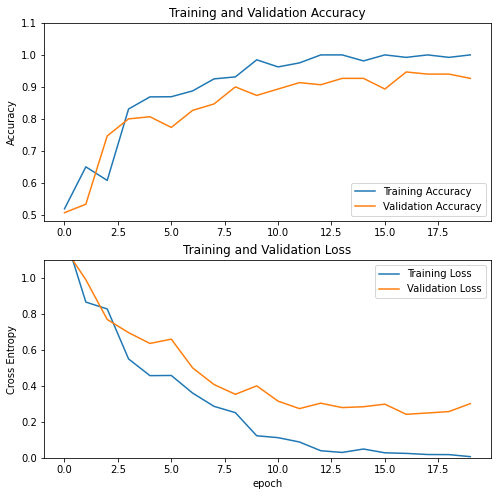
Once the model is trained we can make predictions (for simplicity I’ll use the test dataset since we don’t have a validation set)
The model returns probabilities of belonging to each class, I’ll take the maximum to predict the class
class_testlabels = {v:k for k, v in test_generator.class_indices.items()}
sample_test_images, sample_test_labels = next(test_generator)
raw_prediction = model_1.predict(sample_test_images)
sample_prob_prediction = np.max(raw_prediction, axis=1)
sample_class_prediction = np.argmax(raw_prediction, axis=1)
#predictions for sample test
for r,c,p in zip(sample_test_labels[:10], sample_class_prediction[:10], sample_prob_prediction[:10]):
print("Real label: %s -> Predicted label: %s with %s probability"%(class_testlabels[r],class_testlabels[c], np.round(p,3)))
Real label: lion -> Predicted label: lion with 0.998 probability
Real label: uris -> Predicted label: uris with 0.999 probability
Real label: uris -> Predicted label: uris with 0.882 probability
Real label: alma_matter -> Predicted label: alma_matter with 1.0 probability
Real label: alma_matter -> Predicted label: alma_matter with 0.999 probability
Real label: uris -> Predicted label: alma_matter with 0.772 probability
Real label: alma_matter -> Predicted label: alma_matter with 0.999 probability
Real label: lion -> Predicted label: lion with 0.999 probability
Real label: lion -> Predicted label: lion with 1.0 probability
Real label: alma_matter -> Predicted label: alma_matter with 0.997 probability
Can we do better?
Transfer learning: VGG16 model
I’ll use Keras applications module to load the well known VGG16 model. This allow us to use a far more complex archquitecture as the base of a model without the hassle of having to train it.
I’ll use VGG16 model with weights from ‘imagenet’ and set the layers to not be trainable.
base_model = tf.keras.applications.VGG16(include_top=False, weights ='imagenet',
input_shape = (IMG_SIZE, IMG_SIZE, 3))
base_model.trainable = False
Downloading data from https://storage.googleapis.com/tensorflow/keras-applications/vgg16/vgg16_weights_tf_dim_ordering_tf_kernels_notop.h5
58892288/58889256 [==============================] - 1s 0us/step
Add two top layers to the base model of VGG16 to average last layer and predict:
global_average_layer = tf.keras.layers.GlobalAveragePooling2D()
prediction_layer = tf.keras.layers.Dense(3, activation='softmax')
# build a new model reusing the pretrained base
tl_model = tf.keras.Sequential([
base_model,
global_average_layer,
prediction_layer])
tl_model.summary()
Model: "sequential_1"
_________________________________________________________________
Layer (type) Output Shape Param #
=================================================================
vgg16 (Functional) (None, 8, 8, 512) 14714688
_________________________________________________________________
global_average_pooling2d (Gl (None, 512) 0
_________________________________________________________________
dense_1 (Dense) (None, 3) 1539
=================================================================
Total params: 14,716,227
Trainable params: 1,539
Non-trainable params: 14,714,688
_________________________________________________________________
From the model summary, we can actually see that the number of parameters that are going to be trained is actually very small. This makes the online deployment of the model on a website to be much more lighter.
Compile and train:
tl_model.compile(optimizer=tf.keras.optimizers.Adam(learning_rate=0.001),
loss='sparse_categorical_crossentropy',
metrics=['accuracy'])
history = tl_model.fit(
train_generator,
epochs=20,
validation_data=test_generator)
Epoch 1/20
15/15 [==============================] - 467s 33s/step - loss: 1.1784 - accuracy: 0.2538 - val_loss: 1.0918 - val_accuracy: 0.4000
Epoch 2/20
15/15 [==============================] - 457s 31s/step - loss: 1.0578 - accuracy: 0.4803 - val_loss: 1.0228 - val_accuracy: 0.5600
Epoch 3/20
15/15 [==============================] - 457s 31s/step - loss: 0.9812 - accuracy: 0.6893 - val_loss: 0.9391 - val_accuracy: 0.8333
Epoch 4/20
15/15 [==============================] - 456s 31s/step - loss: 0.9133 - accuracy: 0.8646 - val_loss: 0.8740 - val_accuracy: 0.8800
Epoch 5/20
15/15 [==============================] - 455s 31s/step - loss: 0.8588 - accuracy: 0.9097 - val_loss: 0.8195 - val_accuracy: 0.9067
Epoch 6/20
15/15 [==============================] - 461s 31s/step - loss: 0.7877 - accuracy: 0.9555 - val_loss: 0.7711 - val_accuracy: 0.9133
Epoch 7/20
15/15 [==============================] - 457s 31s/step - loss: 0.7368 - accuracy: 0.9257 - val_loss: 0.7283 - val_accuracy: 0.9133
Epoch 8/20
15/15 [==============================] - 457s 31s/step - loss: 0.6867 - accuracy: 0.9530 - val_loss: 0.6827 - val_accuracy: 0.9133
Epoch 9/20
15/15 [==============================] - 460s 31s/step - loss: 0.6576 - accuracy: 0.9500 - val_loss: 0.6372 - val_accuracy: 0.9400
Epoch 10/20
15/15 [==============================] - 458s 31s/step - loss: 0.6150 - accuracy: 0.9813 - val_loss: 0.6017 - val_accuracy: 0.9467
Epoch 11/20
15/15 [==============================] - 460s 31s/step - loss: 0.5691 - accuracy: 0.9796 - val_loss: 0.5722 - val_accuracy: 0.9600
Epoch 12/20
15/15 [==============================] - 459s 31s/step - loss: 0.5327 - accuracy: 0.9778 - val_loss: 0.5501 - val_accuracy: 0.9600
Epoch 13/20
15/15 [==============================] - 457s 31s/step - loss: 0.5183 - accuracy: 0.9841 - val_loss: 0.5138 - val_accuracy: 0.9533
Epoch 14/20
15/15 [==============================] - 455s 30s/step - loss: 0.5042 - accuracy: 0.9758 - val_loss: 0.4911 - val_accuracy: 0.9533
Epoch 15/20
15/15 [==============================] - 455s 32s/step - loss: 0.4698 - accuracy: 0.9781 - val_loss: 0.4691 - val_accuracy: 0.9600
Epoch 16/20
15/15 [==============================] - 454s 30s/step - loss: 0.4298 - accuracy: 0.9836 - val_loss: 0.4459 - val_accuracy: 0.9533
Epoch 17/20
15/15 [==============================] - 454s 30s/step - loss: 0.4059 - accuracy: 0.9860 - val_loss: 0.4292 - val_accuracy: 0.9533
Epoch 18/20
15/15 [==============================] - 455s 30s/step - loss: 0.3917 - accuracy: 0.9920 - val_loss: 0.4204 - val_accuracy: 0.9600
Epoch 19/20
15/15 [==============================] - 458s 31s/step - loss: 0.3790 - accuracy: 0.9906 - val_loss: 0.3938 - val_accuracy: 0.9533
Epoch 20/20
15/15 [==============================] - 454s 30s/step - loss: 0.3572 - accuracy: 0.9933 - val_loss: 0.3812 - val_accuracy: 0.9600
We can see an improvement in terms of accuracy for the validation set: 96%. Let’s visualize its metrics:
plot_metrics(history)
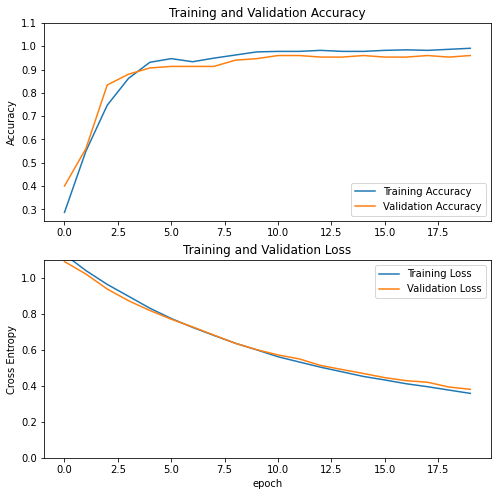
Can we still keep improving the model?
Fine tune top layers of base model
We can actually train some of the layers of the base model: bottom layers capture more fundamental shapes and patterns of images, but top layers actually learn features more specific to the dataset in hand.
base_model.trainable = True
#how many layers are in the base model
print("Number of layers in the base model: ", len(base_model.layers))
# Fine-tune from this layer onwards
fine_tune_at = 17
# Freeze all the layers before the `fine_tune_at` layer
for layer in base_model.layers[:fine_tune_at]:
layer.trainable = False
Number of layers in the base model: 19
Out of the 19 layers of VGG16, let’s train the last 2 layers.
tl_model.compile(optimizer=tf.keras.optimizers.Adam(learning_rate=0.0001/10),
loss='sparse_categorical_crossentropy',
metrics=['accuracy'])
tl_model.summary()
Model: "sequential_1"
_________________________________________________________________
Layer (type) Output Shape Param #
=================================================================
vgg16 (Functional) (None, 8, 8, 512) 14714688
_________________________________________________________________
global_average_pooling2d (Gl (None, 512) 0
_________________________________________________________________
dense_1 (Dense) (None, 3) 1539
=================================================================
Total params: 14,716,227
Trainable params: 2,361,347
Non-trainable params: 12,354,880
_________________________________________________________________
From the summary of this new model, we can see that by training the last 2 top layers plus the last layers to predict, the model becomes bigger: from 1,539 to 4,721,155 trainable parameters. Let’s train from the last epoch of the previous model:
history_2 = tl_model.fit(
train_generator,
epochs=20+20,
initial_epoch = history.epoch[-1],
validation_data=test_generator)
Epoch 20/40
15/15 [==============================] - 469s 32s/step - loss: 0.3634 - accuracy: 0.9767 - val_loss: 0.3147 - val_accuracy: 0.9600
Epoch 21/40
15/15 [==============================] - 467s 32s/step - loss: 0.2713 - accuracy: 0.9957 - val_loss: 0.2575 - val_accuracy: 0.9600
Epoch 22/40
15/15 [==============================] - 467s 31s/step - loss: 0.2130 - accuracy: 0.9981 - val_loss: 0.2146 - val_accuracy: 0.9600
Epoch 23/40
15/15 [==============================] - 468s 31s/step - loss: 0.1776 - accuracy: 0.9864 - val_loss: 0.1868 - val_accuracy: 0.9600
Epoch 24/40
15/15 [==============================] - 465s 31s/step - loss: 0.1412 - accuracy: 0.9920 - val_loss: 0.1577 - val_accuracy: 0.9600
Epoch 25/40
15/15 [==============================] - 466s 31s/step - loss: 0.1118 - accuracy: 0.9975 - val_loss: 0.1361 - val_accuracy: 0.9600
Epoch 26/40
15/15 [==============================] - 465s 31s/step - loss: 0.0943 - accuracy: 0.9968 - val_loss: 0.1246 - val_accuracy: 0.9600
Epoch 27/40
15/15 [==============================] - 466s 31s/step - loss: 0.0833 - accuracy: 0.9996 - val_loss: 0.1073 - val_accuracy: 0.9733
Epoch 28/40
15/15 [==============================] - 464s 31s/step - loss: 0.0648 - accuracy: 0.9985 - val_loss: 0.0999 - val_accuracy: 0.9733
Epoch 29/40
15/15 [==============================] - 470s 32s/step - loss: 0.0627 - accuracy: 0.9978 - val_loss: 0.0909 - val_accuracy: 0.9733
Epoch 30/40
15/15 [==============================] - 464s 31s/step - loss: 0.0543 - accuracy: 0.9953 - val_loss: 0.0809 - val_accuracy: 0.9733
Epoch 31/40
15/15 [==============================] - 464s 31s/step - loss: 0.0470 - accuracy: 0.9996 - val_loss: 0.0762 - val_accuracy: 0.9733
Epoch 32/40
15/15 [==============================] - 464s 31s/step - loss: 0.0393 - accuracy: 1.0000 - val_loss: 0.0708 - val_accuracy: 0.9733
Epoch 33/40
15/15 [==============================] - 464s 31s/step - loss: 0.0339 - accuracy: 1.0000 - val_loss: 0.0663 - val_accuracy: 0.9800
Epoch 34/40
15/15 [==============================] - 464s 31s/step - loss: 0.0330 - accuracy: 0.9981 - val_loss: 0.0629 - val_accuracy: 0.9800
Epoch 35/40
15/15 [==============================] - 464s 31s/step - loss: 0.0314 - accuracy: 1.0000 - val_loss: 0.0579 - val_accuracy: 0.9800
Epoch 36/40
15/15 [==============================] - 463s 31s/step - loss: 0.0282 - accuracy: 1.0000 - val_loss: 0.0565 - val_accuracy: 0.9800
Epoch 37/40
15/15 [==============================] - 465s 31s/step - loss: 0.0254 - accuracy: 1.0000 - val_loss: 0.0557 - val_accuracy: 0.9800
Epoch 38/40
15/15 [==============================] - 463s 31s/step - loss: 0.0209 - accuracy: 1.0000 - val_loss: 0.0525 - val_accuracy: 0.9800
Epoch 39/40
15/15 [==============================] - 464s 31s/step - loss: 0.0191 - accuracy: 1.0000 - val_loss: 0.0488 - val_accuracy: 0.9800
Epoch 40/40
15/15 [==============================] - 464s 31s/step - loss: 0.0213 - accuracy: 1.0000 - val_loss: 0.0492 - val_accuracy: 0.9867
We can see that for this round of training, the accuracy of the test set improves and the train set actually reaches 100% of accuracy.
plot_metrics(history_2)
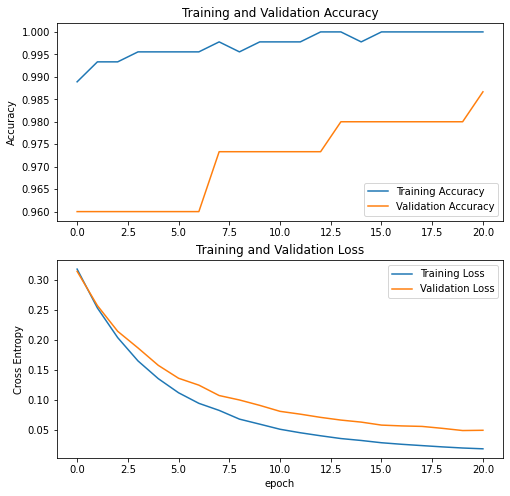
Here, we need to make a decision based on the trade off of accuracy (and overfitting) vs. size of the model. Since the improvement in accuracy is not significantly higher, let’s keep the simpler VGG16 base model without trainable layers, having in mind this model would be lighter to load and deploy on a website.
Save model to Keras h5 format
tl_model.save("/content/columbiamodel.h5")
auth.authenticate_user()
gauth = GoogleAuth()
gauth.credentials = GoogleCredentials.get_application_default()
drive = GoogleDrive(gauth)
file1 = drive.CreateFile({"title": 'columbiamodel.h5'})
file1.SetContentFile('/content/columbiamodel.h5')
file1.Upload()
Convert Keras h5 model with js and download to google drive
!pip install -U tensorflowjs==1.2.6
Collecting tensorflowjs==1.2.6
Downloading https://files.pythonhosted.org/packages/e7/6a/b8da7692e9a289edbb83f4693ceb2c0be270ad30a5aee7438627e562ff95/tensorflowjs-1.2.6-py3-none-any.whl
Collecting tensorflow-hub==0.5.0
[?25l Downloading https://files.pythonhosted.org/packages/b5/be/f18c352d84382d9c795a0f37eaf16d42ace7d161fbb0ad20bdcd5e550015/tensorflow_hub-0.5.0-py2.py3-none-any.whl (78kB)
[K |████████████████████████████████| 81kB 6.7MB/s
[?25hCollecting tensorflow==1.14.0
[?25l Downloading https://files.pythonhosted.org/packages/de/f0/96fb2e0412ae9692dbf400e5b04432885f677ad6241c088ccc5fe7724d69/tensorflow-1.14.0-cp36-cp36m-manylinux1_x86_64.whl (109.2MB)
[K |████████████████████████████████| 109.2MB 115kB/s
[?25hCollecting h5py==2.8.0
[?25l Downloading https://files.pythonhosted.org/packages/8e/cb/726134109e7bd71d98d1fcc717ffe051767aac42ede0e7326fd1787e5d64/h5py-2.8.0-cp36-cp36m-manylinux1_x86_64.whl (2.8MB)
[K |████████████████████████████████| 2.8MB 59.7MB/s
[?25hCollecting numpy==1.16.4
[?25l Downloading https://files.pythonhosted.org/packages/87/2d/e4656149cbadd3a8a0369fcd1a9c7d61cc7b87b3903b85389c70c989a696/numpy-1.16.4-cp36-cp36m-manylinux1_x86_64.whl (17.3MB)
[K |████████████████████████████████| 17.3MB 236kB/s
[?25hCollecting six==1.11.0
Downloading https://files.pythonhosted.org/packages/67/4b/141a581104b1f6397bfa78ac9d43d8ad29a7ca43ea90a2d863fe3056e86a/six-1.11.0-py2.py3-none-any.whl
Collecting keras==2.2.4
[?25l Downloading https://files.pythonhosted.org/packages/5e/10/aa32dad071ce52b5502266b5c659451cfd6ffcbf14e6c8c4f16c0ff5aaab/Keras-2.2.4-py2.py3-none-any.whl (312kB)
[K |████████████████████████████████| 317kB 60.1MB/s
[?25hRequirement already satisfied, skipping upgrade: protobuf>=3.4.0 in /usr/local/lib/python3.6/dist-packages (from tensorflow-hub==0.5.0->tensorflowjs==1.2.6) (3.10.0)
Requirement already satisfied, skipping upgrade: wrapt>=1.11.1 in /usr/local/lib/python3.6/dist-packages (from tensorflow==1.14.0->tensorflowjs==1.2.6) (1.12.1)
Requirement already satisfied, skipping upgrade: keras-preprocessing>=1.0.5 in /usr/local/lib/python3.6/dist-packages (from tensorflow==1.14.0->tensorflowjs==1.2.6) (1.1.2)
Requirement already satisfied, skipping upgrade: termcolor>=1.1.0 in /usr/local/lib/python3.6/dist-packages (from tensorflow==1.14.0->tensorflowjs==1.2.6) (1.1.0)
Collecting tensorflow-estimator<1.15.0rc0,>=1.14.0rc0
[?25l Downloading https://files.pythonhosted.org/packages/3c/d5/21860a5b11caf0678fbc8319341b0ae21a07156911132e0e71bffed0510d/tensorflow_estimator-1.14.0-py2.py3-none-any.whl (488kB)
[K |████████████████████████████████| 491kB 57.2MB/s
[?25hRequirement already satisfied, skipping upgrade: gast>=0.2.0 in /usr/local/lib/python3.6/dist-packages (from tensorflow==1.14.0->tensorflowjs==1.2.6) (0.3.3)
Requirement already satisfied, skipping upgrade: keras-applications>=1.0.6 in /usr/local/lib/python3.6/dist-packages (from tensorflow==1.14.0->tensorflowjs==1.2.6) (1.0.8)
Requirement already satisfied, skipping upgrade: astor>=0.6.0 in /usr/local/lib/python3.6/dist-packages (from tensorflow==1.14.0->tensorflowjs==1.2.6) (0.8.1)
Collecting tensorboard<1.15.0,>=1.14.0
[?25l Downloading https://files.pythonhosted.org/packages/91/2d/2ed263449a078cd9c8a9ba50ebd50123adf1f8cfbea1492f9084169b89d9/tensorboard-1.14.0-py3-none-any.whl (3.1MB)
[K |████████████████████████████████| 3.2MB 43.1MB/s
[?25hRequirement already satisfied, skipping upgrade: grpcio>=1.8.6 in /usr/local/lib/python3.6/dist-packages (from tensorflow==1.14.0->tensorflowjs==1.2.6) (1.29.0)
Requirement already satisfied, skipping upgrade: google-pasta>=0.1.6 in /usr/local/lib/python3.6/dist-packages (from tensorflow==1.14.0->tensorflowjs==1.2.6) (0.2.0)
Requirement already satisfied, skipping upgrade: wheel>=0.26 in /usr/local/lib/python3.6/dist-packages (from tensorflow==1.14.0->tensorflowjs==1.2.6) (0.34.2)
Requirement already satisfied, skipping upgrade: absl-py>=0.7.0 in /usr/local/lib/python3.6/dist-packages (from tensorflow==1.14.0->tensorflowjs==1.2.6) (0.9.0)
Requirement already satisfied, skipping upgrade: pyyaml in /usr/local/lib/python3.6/dist-packages (from keras==2.2.4->tensorflowjs==1.2.6) (3.13)
Requirement already satisfied, skipping upgrade: scipy>=0.14 in /usr/local/lib/python3.6/dist-packages (from keras==2.2.4->tensorflowjs==1.2.6) (1.4.1)
Requirement already satisfied, skipping upgrade: setuptools in /usr/local/lib/python3.6/dist-packages (from protobuf>=3.4.0->tensorflow-hub==0.5.0->tensorflowjs==1.2.6) (47.1.1)
Requirement already satisfied, skipping upgrade: werkzeug>=0.11.15 in /usr/local/lib/python3.6/dist-packages (from tensorboard<1.15.0,>=1.14.0->tensorflow==1.14.0->tensorflowjs==1.2.6) (1.0.1)
Requirement already satisfied, skipping upgrade: markdown>=2.6.8 in /usr/local/lib/python3.6/dist-packages (from tensorboard<1.15.0,>=1.14.0->tensorflow==1.14.0->tensorflowjs==1.2.6) (3.2.2)
Requirement already satisfied, skipping upgrade: importlib-metadata; python_version < "3.8" in /usr/local/lib/python3.6/dist-packages (from markdown>=2.6.8->tensorboard<1.15.0,>=1.14.0->tensorflow==1.14.0->tensorflowjs==1.2.6) (1.6.0)
Requirement already satisfied, skipping upgrade: zipp>=0.5 in /usr/local/lib/python3.6/dist-packages (from importlib-metadata; python_version < "3.8"->markdown>=2.6.8->tensorboard<1.15.0,>=1.14.0->tensorflow==1.14.0->tensorflowjs==1.2.6) (3.1.0)
[31mERROR: umap-learn 0.4.3 has requirement numpy>=1.17, but you'll have numpy 1.16.4 which is incompatible.[0m
[31mERROR: google-colab 1.0.0 has requirement six~=1.12.0, but you'll have six 1.11.0 which is incompatible.[0m
[31mERROR: datascience 0.10.6 has requirement folium==0.2.1, but you'll have folium 0.8.3 which is incompatible.[0m
[31mERROR: albumentations 0.1.12 has requirement imgaug<0.2.7,>=0.2.5, but you'll have imgaug 0.2.9 which is incompatible.[0m
Installing collected packages: six, numpy, tensorflow-hub, tensorflow-estimator, tensorboard, tensorflow, h5py, keras, tensorflowjs
Found existing installation: six 1.12.0
Uninstalling six-1.12.0:
Successfully uninstalled six-1.12.0
Found existing installation: numpy 1.18.4
Uninstalling numpy-1.18.4:
Successfully uninstalled numpy-1.18.4
Found existing installation: tensorflow-hub 0.8.0
Uninstalling tensorflow-hub-0.8.0:
Successfully uninstalled tensorflow-hub-0.8.0
Found existing installation: tensorflow-estimator 2.2.0
Uninstalling tensorflow-estimator-2.2.0:
Successfully uninstalled tensorflow-estimator-2.2.0
Found existing installation: tensorboard 2.2.2
Uninstalling tensorboard-2.2.2:
Successfully uninstalled tensorboard-2.2.2
Found existing installation: tensorflow 2.2.0
Uninstalling tensorflow-2.2.0:
Successfully uninstalled tensorflow-2.2.0
Found existing installation: h5py 2.10.0
Uninstalling h5py-2.10.0:
Successfully uninstalled h5py-2.10.0
Found existing installation: Keras 2.3.1
Uninstalling Keras-2.3.1:
Successfully uninstalled Keras-2.3.1
Successfully installed h5py-2.8.0 keras-2.2.4 numpy-1.16.4 six-1.11.0 tensorboard-1.14.0 tensorflow-1.14.0 tensorflow-estimator-1.14.0 tensorflow-hub-0.5.0 tensorflowjs-1.2.6
!mkdir tfjs_model
!tensorflowjs_converter --input_format=keras \
/content/columbiamodel.h5 \
/content/tfjs_model
[f for f in os.listdir('/content/tfjs_model/')]
['group1-shard15of15.bin',
'group1-shard6of15.bin',
'group1-shard2of15.bin',
'group1-shard3of15.bin',
'group1-shard9of15.bin',
'group1-shard11of15.bin',
'group1-shard7of15.bin',
'group1-shard14of15.bin',
'group1-shard4of15.bin',
'group1-shard1of15.bin',
'group1-shard13of15.bin',
'group1-shard10of15.bin',
'group1-shard5of15.bin',
'model.json',
'group1-shard12of15.bin',
'group1-shard8of15.bin']
auth.authenticate_user()
gauth = GoogleAuth()
gauth.credentials = GoogleCredentials.get_application_default()
drive = GoogleDrive(gauth)
bin_files = [f for f in os.listdir('/content/tfjs_model/')] #binfiles and model.json
for name in bin_files:
#name = key + '.bin'
uploaded = drive.CreateFile({'title': name})
print("Uploading {} file ...".format(name))
uploaded.SetContentFile('/content/tfjs_model/%s'%name)
uploaded.Upload()
Uploading group1-shard15of15.bin file ...
Uploading group1-shard6of15.bin file ...
Uploading group1-shard2of15.bin file ...
Uploading group1-shard3of15.bin file ...
Uploading group1-shard9of15.bin file ...
Uploading group1-shard11of15.bin file ...
Uploading group1-shard7of15.bin file ...
Uploading group1-shard14of15.bin file ...
Uploading group1-shard4of15.bin file ...
Uploading group1-shard1of15.bin file ...
Uploading group1-shard13of15.bin file ...
Uploading group1-shard10of15.bin file ...
Uploading group1-shard5of15.bin file ...
Uploading model.json file ...
Uploading group1-shard12of15.bin file ...
Uploading group1-shard8of15.bin file ...
The bin files along with the model in json format are going to be use to deploy the classifier model on a simple website using TensorFlow.js
Visit: https://jacquelinearaya.github.io/portfolio/modelindex to see the model deployed.
